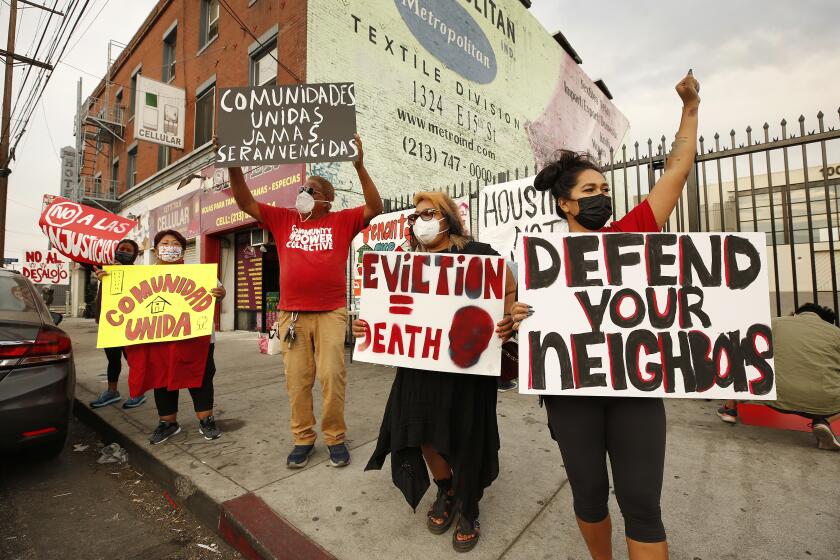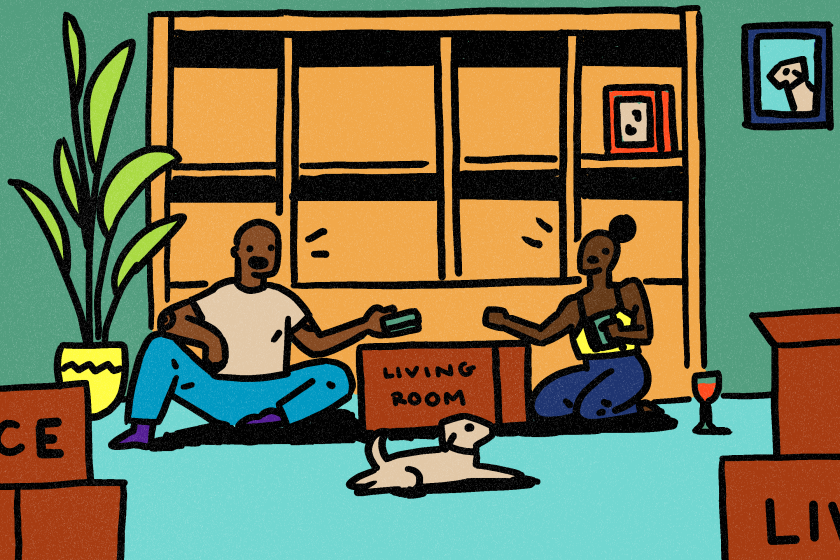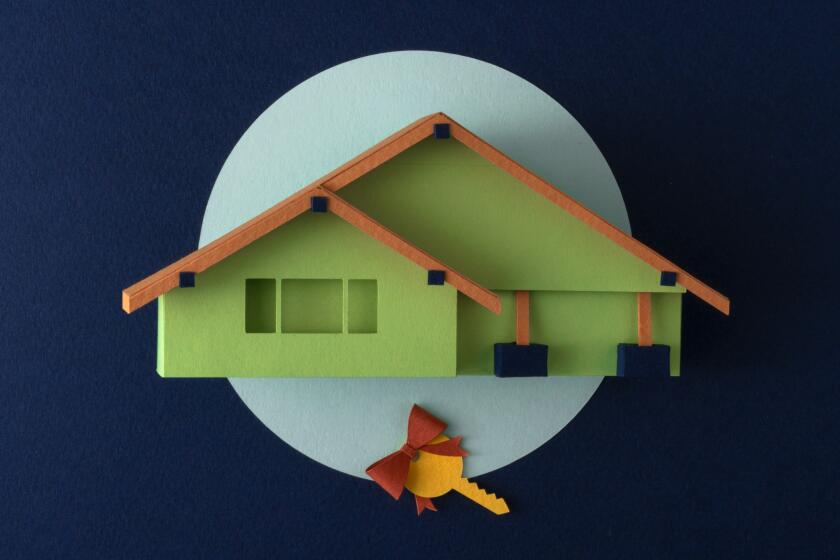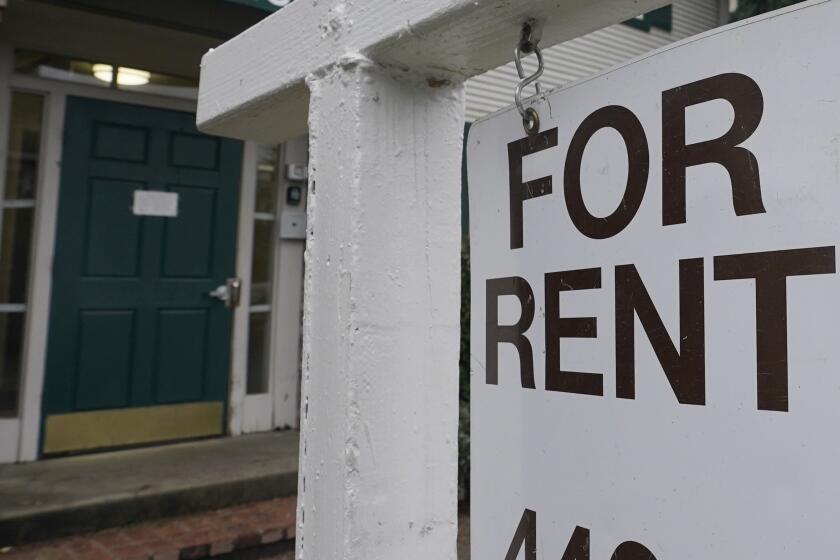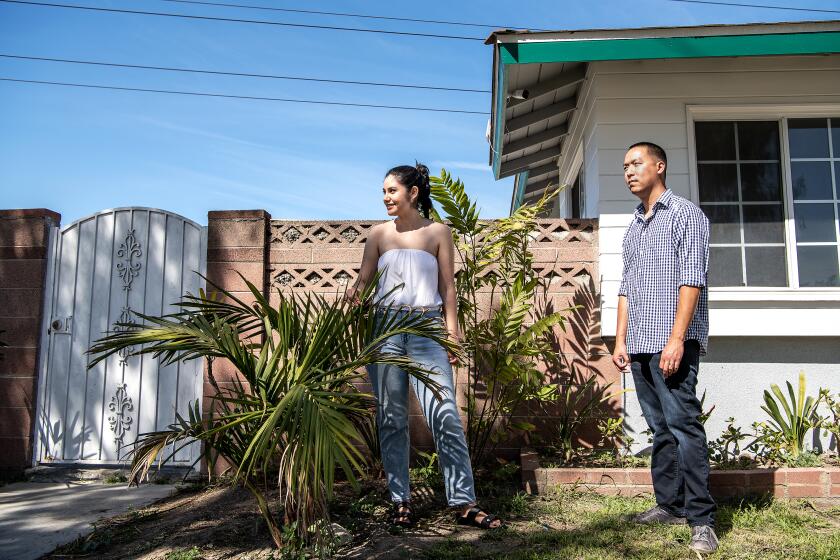Finding a place to rent in Los Angeles has become a competitive sport
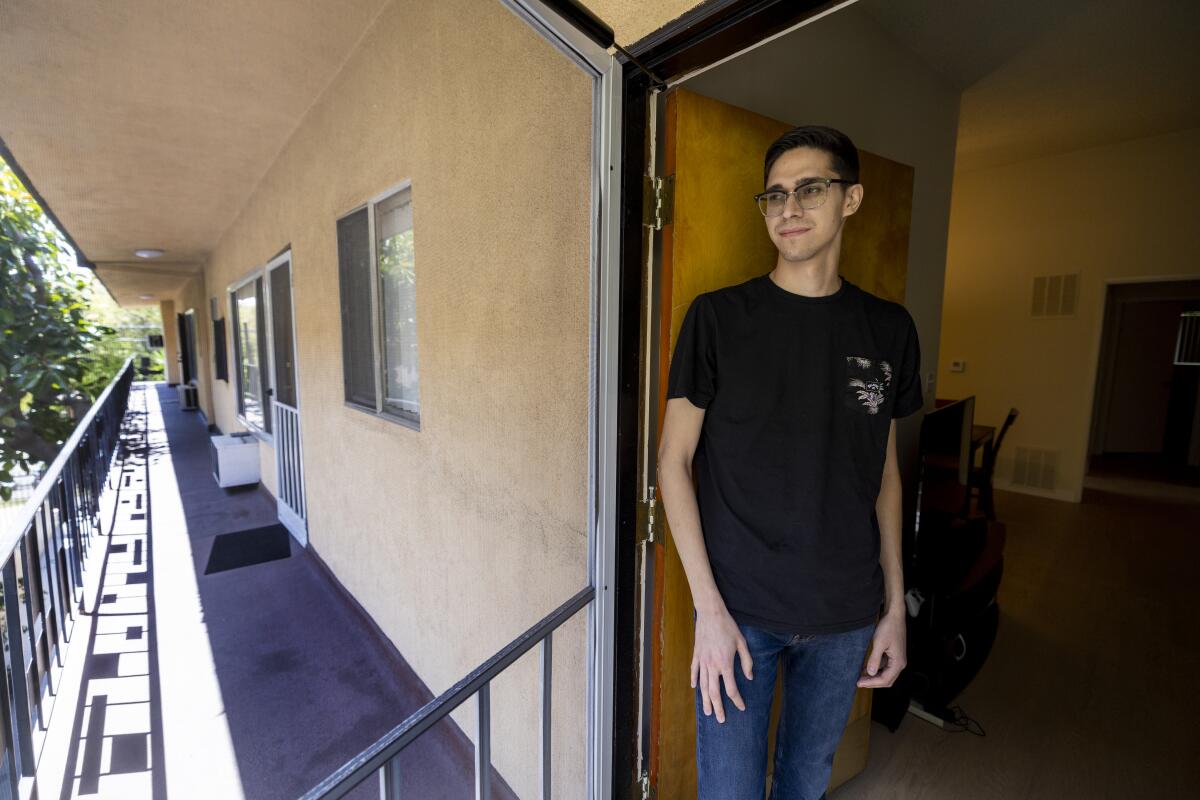
- Share via
Bidding wars for houses are a common ordeal in Southern California, a sort of painful induction process that spits out a now-decreasing number of victors into the ranks of homeowners.
But for an apartment to rent?
The availability of apartments in Los Angeles and surrounding counties is so tight that some renters are paying above list price to secure a high-quality unit, while others jostle for the remaining stock of apartments.
“Everyone is just battling for the same places,” said Anna Maciaszek, who moved to Los Angeles in January and has been living in short-term rentals as she looks for a permanent apartment.
The number of apartments available for rent in L.A. County is the lowest it’s been in two decades, while listings in the Inland Empire and Orange County are below or near records set before the COVID-19 pandemic.
In L.A. County, rent is up 16% from a year ago, when the rental market was still subdued by people who moved in with family or headed inland for more space during the pandemic. With demand back up, landlords have a strong hand again in setting terms and prices.
Maciaszek, 35, came to L.A. from Florida without a job but quickly found one as an account coordinator with a media company. She figured she could afford $2,000 a month in rent and planned to move out of her short-term rental in Atwater Village before it expired at the end of April.
She estimated that she reached out to more than 50 landlords and leasing agents. Most told her the unit she was interested in had already been rented, or didn’t return messages. Online listings within her budget sometimes noted a couple of hundred people already had contacted the landlord by the time she found the ads.
For the most financially vulnerable, the competition has meant no housing at all.
“I was living in my car all of winter,” said Madi Cipris, a 25-year-old casino worker who said she could afford to rent a studio apartment but kept getting rejected for not meeting many landlords’ income qualifications.
She eventually found a “tiny, tiny room” for $1,000 a month in a house in Menifee in Riverside County.
Evictions and rent increases still are limited in Los Angeles and many other parts of Southern California. But the rules vary from city to city.
The Southern California rental market, like the for-sale market, has long been among the nation’s most competitive. Economists say there simply isn’t enough housing built for an area with plentiful jobs and idyllic weather.
Now, a new mix of factors driven by the pandemic and a recovering economy are making the situation worse, experts said. Recent college grads or people in their early career years, usually renters, are moving to town for new jobs. In the region more broadly, as some people eager for the return to city life head back to L.A., others continue to head to the Inland Empire for space, where they also compete for low stock.
The vacancy rate in Los Angeles County in the first quarter of this year was the lowest since 2001, according to real estate firm CoStar, which tracks apartment buildings with five or more units and defines a vacant unit as one that is not occupied and is available to rent.
In the Inland Empire, the vacancy rate last year was at its lowest since at least 1981, and has risen only slightly.
The vacancy rate hit record lows nationwide in 2021, but the exact reason for the drop in available apartments differs, to some extent, depending on location.
Several factors are contributing across the board, said Jay Lybik, a CoStar analyst. Rising home values — the brutal for-sale market — are locking people out of homeownership, meaning they remain renters longer.
There was also a “double graduation boom” in 2021, Lybik said, as young adults who moved home after graduating from college in 2020 looked for housing at the same time as those who graduated last year.
And, it hasn’t gotten much easier or faster to add housing supply in California: Time-consuming approval processes hamper the ability to quickly ramp up construction, and supply chain breakdowns add further delays.
All that doesn’t neatly explain housing and mobility patterns in Los Angeles County since the pandemic started.
This month, state researchers reported that the county’s population declined by 70,114 in 2021, which might suggest that people moving out of the region would free up apartments.
But demographic experts said population and vacancy could fall simultaneously if larger families moved away, while single people and smaller families moved in.
There isn’t yet data to confirm that was the case last year, and it’s possible the state data are slow to catch recent arrivals.

Subscribers get exclusive access to this story
We’re offering L.A. Times subscribers special access to our best journalism. Thank you for your support.
Explore more Subscriber Exclusive content.
Dowell Myers, a professor of policy, planning and demography at USC, said it’s plausible that couples with children were more likely to leave in 2021 as the pandemic dragged on and more likely to stay put as Los Angeles fully reopened.
“It’s people who are looking for partners who are more likely to come back,” he said. “The action is really back in the middle of the city.”
Nick Garcia, 25, kept a spreadsheet during his two-month-long apartment search that amassed 50 entries and helped him keep track of apparent scams, landlords who didn’t return calls and other red flags.
Garcia, who moved from Tucson for a job at Disney, landed a relatively good deal on a $2,100 two-bedroom in Hollywood that he shares with a roommate. The experience was sobering for a newcomer not used to bare-bones L.A. rentals, which don’t routinely include amenities such as refrigerators, air conditioning or laundry hook-ups.
“I’m paying triple the rent that I was in Arizona [for] probably half the amenities,” he said. “Landlords are trying to just test how high they can go with a price.”
Moving often brings a lot of stress and anxiety. But local moving professionals explain how some extra planning can make your move day go smoothly.
Landlords in power
In interviews, landlords said they increasingly see people moving to Los Angeles to start a new job. The return of in-person learning at colleges, and employers reopening offices, has also brought back to the market people who had doubled up with family and friends or temporarily rented elsewhere, analysts said.
Overall, the Los Angeles County vacancy rate was 3.5% in the first quarter of this year, the lowest since 2001 and down from 6% during late 2020, according to CoStar.
Carl Whitaker, director of research at rental software firm RealPage, said part of L.A.’s falling vacancy rate probably is because fully opened theaters, restaurants and bars are reminding renters why they paid top dollar to live in urban areas.
In the last year, RealPage data show, the largest vacancy-rate declines have come in the normally entertainment- and job-rich neighborhoods of downtown Los Angeles and the Westside. Hollywood was among the areas seeing the biggest reductions as well.
The lack of available housing is giving Los Angeles landlords pricing power they didn’t have during the pandemic.
A no-BS guide to buying your first home in Southern California.
Daniel Tenenbaum, founding principal of Pacific Crest Real Estate, said deciding how much to increase rent is a combination of “science and art.” The science is looking at what competitors charge, and the art is seeing how fast Pacific Crest’s apartments lease, then recalibrating.
“Vacancy and pricing all comes down to supply and demand,” he said. “So the last unit that was at, let’s say, $1,700 got leased up in three days, where it used to be two to three weeks. ... On the next vacancy we will increase it a little bit and see how that goes.”
Tenenbaum said his company is now leasing vacant apartments, quickly, for 7% to 12% more than last year, a reversal from 2020 when it dropped rent to get people in the door at its properties in central Los Angeles and the San Fernando Valley.
Rent data are tricky since what a landlord charges isn’t a public record and different data firms employ different methods, but multiple sources indicate many landlords have the ability Tenenbaum does.
Across L.A. County, the median rent in April for all sizes of vacant apartments jumped nearly 16% from a year earlier, to $1,897, according to data from rental website Apartment List.
Median rent in L.A. County is up nearly 10% from February 2020, the month before pandemic lockdowns began.
“I started my company in 1995,” Tenenbaum said. “I have never seen vacancy and the market this tight.”
In addition to falling vacancy, some in the real estate industry point to an inflationary spiral as a reason rents are heading higher.
Rising incomes have given many tenants the ability to pay at least somewhat more. And housing is costing more to maintain, some landlords said.
One major Southern California landlord, who asked not to be named because of the potential to be perceived negatively, said he’s raising rent more than he otherwise would to cover the rising cost of water, cleaning supplies and raises given to retain and attract property management staff.
“All these costs are increasing and landlords also suffered from lagging rent collection for the past two years,” said Dan Yukelson, executive director of the Apartment Assn. of Greater Los Angeles. “They need to recover those costs.”
Getting your first apartment is a big deal, and in Los Angeles, it can be a big pain. Here are tips for navigating the process — from searching for openings to touring units to signing the lease.
Chasing space
In the Inland Empire, the vacancy rate fell to the lowest level since at least 1981 last year as people, untethered from commutes, increasingly moved to Riverside and San Bernardino counties in search of more spacious, affordable housing.
The vacancy rate plunged to 2% in the second quarter of 2021 from 5.4% at the beginning of 2020, a record low in a CoStar data set going back to 1982.
It has since risen — possibly because more people are moving back to urban areas — but remains less than 3% and at pre-pandemic lows.
With demand still far outstripping supply, median rent for an Inland Empire vacant apartment didn’t decline during the pandemic — as it did in L.A. and other big cities — and last month was 36% above the February 2020 median, according to Apartment List data.
At $1,964, the Inland Empire median rent is now above the L.A. County median, showing just how much the pandemic reshaped the rental market in Riverside and San Bernardino counties. Other sources such as CoStar still show L.A. County as more expensive, a reflection of differences in how rent is measured in different data sets.
Cipris, who was temporarily homeless and now lives in the Menifee house, said she had to find new housing last year but came up empty and sent her 3-year-old daughter to live with her father while she searched.
She said she saw apartments renting for $1,200 a month that she knew she could afford, but couldn’t meet landlord income qualifications of three times the monthly rent. She already worked multiple part-time jobs as a casino worker, Instacart driver and barback.
For months, the denials kept coming. At night she pulled her car into the Walmart parking lot in Murrieta, kept it running to keep warm and tried to sleep.
In February, she found a $1,000-a-month room in a Menifee house after she posted on Facebook, explaining she was a single mother looking for housing.
She said she and her daughter now live with another single mom and her two children.
Income requirements for renters, often set at three times the monthly rent, aren’t new, said Yukelson of the apartment association. But increased regulations governing evictions and tenant rights — both in the years before and during the pandemic — mean landlords “aren’t willing to take a chance on the nice couple that walks in anymore.”
Most people don’t buy a home with a 20% down payment. Here’s how you can put down less and get more help with down payment and closing costs.
Tenants staying in place face less difficulty.
A hodgepodge of rules limit rent increases on existing tenants in most California apartment buildings. And landlords say they generally don’t like to raise the rent on existing tenants, preferring to avoid the hassle and expense of a vacancy.
In Los Angeles, tenants living in units built on or before Oct. 1, 1978, are protected from any price hikes under pandemic rules that remain in place for at least another year.
Landlords of those properties have criticized the restriction, saying they feel increasingly pinched by inflation.
These days, some aspiring tenants are also contributing to pushing rents higher.
Take, for example, a drab two-bedroom condo with a coin-operated laundry that rental agent Fallon Dobrisky first listed in Los Feliz in November 2020. The market was so desolate then that she priced it at $2,500 per month and got just one application.
When Dobrisky, an agent with the Rental Girl brokerage, put it back on the market last month, priced at $3,150, 30 people stopped by the first showing weekend. Offers poured in, many packaged with the so-called love letters that are more common with home purchase bids, which people use to pitch themselves as the perfect match for the property.
The apartment went to someone who offered to pay $3,250 a month, $100 more than the listed rent. Dobrisky said the tactic isn’t the norm, but she’s seeing it more and more in popular neighborhoods with low inventory.
“Renters are trying to stand out,” Dobrisky said. “Offering more than the price is an easy way to set yourself apart.”
What you can do before, during and after your tenancy to get as much of your security deposit back as possible, plus what to do in case of a dispute with your landlord.
More to Read
Sign up for This Evening's Big Stories
Catch up on the day with the 7 biggest L.A. Times stories in your inbox every weekday evening.
You may occasionally receive promotional content from the Los Angeles Times.
